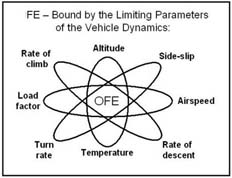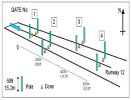 |
Project Aim
To investigate potential improvements to the prediction
of aircraft behaviour before the first flight through development
of high fidelity Modelling and Simulation (M&S) Tools, of direct
assistance in the Flight Test and Evaluation Process, with
particular focus on the ability to test and subsequently expand
the specified boundaries of the Flight Envelope.
|
|
|

|
Flight Test and Evaluation
Before a new or upgraded aircraft becomes operational it must
be certified through an extensive flight-testing process in order
to define the operational flight envelope (OFE, end-user defined
functional limits) and the safe flight envelope (SFE, manufacturer
defined limits of safe flight). During these processes, any aspects
of the performance and handling of the aircraft that need special
pilot attention will also be exposed and if acceptable to th
e operator, some limitations on the operational capability can be
defined within the OFE.
|
|
| |
The current processes are extensive as all areas within the OFE
must at present be tested in flight. The extent to which improved
ground-based predictive and extrapolative capability can support
the qualification/certification process depends on the fidelity of the
M&S tools and facilities. Until relatively recently, fidelity has been
considered satisfactory to guide the testing (Ref 2) but inadequate
for reducing flight test hours in such aspects as flight envelope
expansion, e.g. critical azimuth testing, external load clearance. |
|
| |
 |
|
| |
A ground-based predictive tool could identify/confirm compliant regions
of the FE, allowing a reduction of flight-testing time scales in this region.
It would also highlight problematic regions, allowing further testing to
focus in on non-compliant factors and the defining of the envelope
boundaries. Flight-test safety will also be increased through the pre-flight
identification of boundaries, likely boundary excursions and potential
operational cliff-edges. This project addresses the fidelity aspects of M&S
in flight envelope expansion and aims to develop a suite of tools, using
the latest simulation techniques, of a direct assistance in this process.
|
|
|

|
Modelling and Simulation
Of particular interest in the project is the use of Inverse Simulation (IS)
methods to predict the manoeuvre performance requirements and task
workload when flying mission task elements (MTEs) (Ref 1). The input to
inverse simulation is the flight path or manoeuvre required to be flown
and the output is the pilot control activity and undefined states. If the
manoeuvre is prescribed very tightly or requires high performance from
the aircraft, then there is a risk that the inverse pilot will not be able to
cope with the task effectively and pilot-induced-instabilities can result (Ref 3).
|
|
|

|
The project will use recent developments in inverse simulation, particularly
the SYCOS algorithm (SYnthesis through COnstrained Simulation) (Ref 4)
to develop new procedures for supporting flight envelope expansion. The
flight simulator at Liverpool will be used extensively and tests based on
the Lynx Simulation Model form the basis of SYCOS validation (the same
model can be flown in SYCOS and the flight simulator).
|
|
| |
Inverse Simulation
Inverse Simulation is a desk-top simulation tool used to predict manoeuvre
performance, handling qualities and pilot workload. It obtains a precise,
open-loop, idealistic prediction of the pilot controls and the aircraft response
through a prescribed manoeuvre:
|
|
| |
 |
|
| |
The limitation of this useful tool is that the control activity predicted is not
characteristic of an actual human pilot. The algorithm calculates control
activity that will precisely maintain the prescribed flight path and nullify any
effects of disturbances, which results in an unrepresentative proportion of
high frequency activity. Control limits are not observed and there is no
representation of the compromises and trade-offs a human pilot would make
between guidance and stabilisation when task demands are escalated.
|
|
| |
SYCOS
The SYCOS algorithm was designed by Roy Bradley (Ref 4) to improve on
the limitaions of pure inverse simulation.
|
|
| |
|
|
| |
References
- anon., Aeronautical Design Standard-33E-PRF, Performance
Specification, Handling Qualities Requirements for Military Rotorcraft,
US Army AMCOM, Redstone, Alabama, March 21, 2000.
- Padfield, G.D., et al., Handling Qualities assessment of the UK Attack
Helicopter Competition, 21st European Rotorcraft Forum, St Petersburg,
Russia, Sept 1995
- Padfield, G.D., Charlton, M.T., Jones, J.P., Bradley, R., Where does the
workload go when pilots attack manoeuvres?, 20th European Rotorcraft
Forum, Amsterdam, The Netherlands, Sept 1994
- Bradley, R., Brindley, G., Progress in the Development of a robust pilot
model for the evaluation of rotorcraft performance, control strategy and
pilot workload, 28th European Rotorcraft Forum, Bristol, UK, Sept 2002.
|
|





